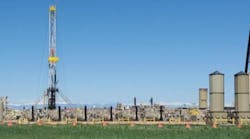ConocoPhillips trims capex by $500 million but sticks to production target
Executives of ConocoPhillips Co., Houston, have reiterated their 2025 production targets even though they’ve trimmed their capital spending budget for the year by $500 million and their adjusted operating costs forecast by $200 million. Among the factors driving those moves is an integration of Marathon Oil Corp. that has gone “pretty seamlessly.”
Chairman and chief executive officer Ryan Lance told analysts on a May 8 conference call that his team isn’t looking to make drastic changes to its activity plans even though commodity prices have slumped amid a volatile macroeconomic environment. ConocoPhillips’ mid-cycle planning price for a barrel of West Texas Intermediate is right around $60, which means “you shouldn’t expect a lot of things to change out of our companies” at current prices.
“For us, it’s, you know, don’t whipsaw this thing too hard right now and use some of the strengths that we have as a company because we can—because of the portfolio that we’re investing in and the opportunity set that’s in front of us,” Lance said. “So don’t overreact but don’t put your head in the sand, either.”
That’s why the lowering of capex and opex targets are the result of small efficiency initiatives across ConocoPhillips’ portfolio and not as focused—as spending cuts recently announced by several notable industry players—on specific operations. The company’s new 2025 target for capex is $12.3-12.6 billion and adjusted operating costs are now forecast to be $10.7-10.9 billion.
“We’re finding ways to deliver the same level of production for less capital and less operating cost. So we kind of think we’re taking a pretty measured approach here,” senior vice-president Andy O’Brien (who will soon take over as chief financial officer) told analysts (OGJ Online, May 12, 2025). “We want to take our time to better understand [the] potential depth or duration of any ongoing commodity price weakness before we determine if we really need to make any changes to our program.”
First-quarter production, second-quarter guidance
ConocoPhillips’ production averaged nearly 2.39 million boe/d in the first 3 months of this year, which was the first period that included the operations of Marathon, which the company acquired late last year (OGJ Online, May 29, 2024). Its assets in the Lower 48 produced an average of 1.46 billion boe/d, with 816,000 boe/d of that coming from the Permian basin, a record 379,000 from the Eagle Ford, and 212,000 from the Bakken.
For the current quarter, Lance and his team are forecasting 2.34-2.38 MMboe/d of total production, in line with the first-quarter number even though ConocoPhillips completed the sales of $1.3 billion worth of assets in Lower 48 early this year.
Shares of ConocoPhillips (Ticker: COP) popped after the earnings report and conference call but gave up some of those gains in the next few trading sessions. On May 12, they were rallying more than 4% to nearly $93 as the broader market rose on the heels of progress in US-China trade talks. Over the past 6 months, they have lost about 15% of their value, which has trimmed the company’s market capitalization to about $117 billion.
About the Author
Geert De Lombaerde
Senior Editor
A native of Belgium, Geert De Lombaerde has more than two decades of business journalism experience and writes about markets and economic trends for Endeavor Business Media publications Healthcare Innovation, IndustryWeek, FleetOwner, Oil & Gas Journal and T&D World. With a degree in journalism from the University of Missouri, he began his reporting career at the Business Courier in Cincinnati and later was managing editor and editor of the Nashville Business Journal. Most recently, he oversaw the online and print products of the Nashville Post and reported primarily on Middle Tennessee’s finance sector as well as many of its publicly traded companies.


